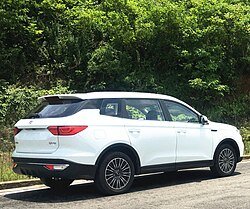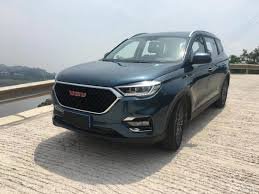When I first heard about the Sinotruk VGV lineup, I thought maybe it was just another overseas SUV that might never make sense for U.S. buyers. But delving into Sinotruk VGV features, price, specs, safety details, and model-to-model comparisons, I realized this brand could shake up what people expect in mid-size crossovers.
Here’s what I found about Sinotruk VGV availability in the US, how the models compare in terms of VGV U75 Plus details vs VGV U70 Pro specs, and what might determine whether VGV can compete here in 2025.
What Is the VGV Brand & Why People Are Talking
VGV is a sub-brand of Weichai (Chongqing) Automotive, itself part of Sinotruk, better known for heavy-duty trucks. Their push into crossovers and SUVs under Sinotruk VGV is recent, but it’s gaining attention in global auto circles. When people search Sinotruk VGV vs competitors SUVs 2025, they often point to the U75 Plus, U70 Pro, and the VX7 as the key models.
For U.S. consumers wondering how much a Sinotruk VGV model costs, keep in mind: official U.S. pricing hasn’t been released yet, and no major U.S. automaker has confirmed full import or sales plans. But spec sheets and overseas pricing make it possible to estimate what a U.S. launch might cost.
Key Models, Price, & Specs
This table provides a comparison between the 3 Sinotruk VGV models: the U75 Plus, U70 Pro, and the VX7.
| Model | Engine Power & Torque | Price / Market Position | Standout Features |
| Sinotruk VGV U75 Plus | 2.0-litre turbocharged engine delivering ~224 hp and ~385 Nm torque; paired with an 8-speed automatic transmission. ● Front-wheel drive layout. | In China, price ranges from ¥137,900 to ¥151,900 (≈ US$18,900-21,000 depending on trim) for the U75 Plus. | 7-seat option; LED headlights; panoramic sunroof; 10.25-inch touchscreen; safety features like lane departure warning, forward collision warning, tyre pressure monitoring; body cage and boron steel B-pillar for side impact protection. |
| Sinotruk VGV U70 Pro | Uses a 1.5-litre turbocharged engine producing about 156 hp / 215 Nm (depending on market). Transmission options may include 6-speed automatic or manual. | Priced lower than U75 Plus in China; launched to appeal to buyers who want many features without stepping up to the premium trim. (Exact launch price varies by region and taxes.) | Offers many of the same design cues (LED lighting, modern infotainment, multi-row seating), though some luxury touches (panoramic sunroof, leather, advanced safety aids) may be optional or only in higher trims. |
| Sinotruk VGV VX7 | Same 2.0-litre turbo 224 hp/385 Nm powertrain as U75 Plus base, with shared 8-speed automatic; slightly different body style in some markets. | A more niche variant, priced above base U75 Plus in markets where pickup styling or utility adds to cost. For example, in Cambodia, VX7 has been priced around US$27,999-29,999 for basic versions. | Useful cargo bed; retains many SUV features (LED lights, 360-degree camera, leather trims in some versions); appeals to buyers wanting crossover comfort with some utility. |
Sinotruk VGV Safety Features
One area I focused on was the Sinotruk VGV safety features because safety often distinguishes success in the U.S. market, and buyers here expect rigorous crash-testing and high standards.
Here’s what the spec sheets show:
- U75 Plus includes driver & passenger airbags, Advanced Braking Systems (ABS, EBD), Traction Control System (TCS), Electronic Stability Program (ESP), Hill-Start Assist (HAC), and forward collision warning (FCW).
- Body design includes a high-strength cage-type structure; boron steel B-pillar in many models for side impact protection.
- Additional features in many trims: 360-degree cameras or panoramic surround view, tyre pressure monitoring system, optional advanced driver assistance features like LDW (Lane Departure Warning).
While none of the sources show U.S. crash ratings (NHTSA or IIHS) yet, these specs suggest Sinotruk VGV is aiming to meet or at least approach standards expected in markets like the U.S. and Europe.
Sinotruk VGV U75 vs U70 Comparison

Since the U75 Plus and U70 Pro are often compared, here is how they stack up:
| Feature | U75 Plus | U70 Pro |
| Engine / Power / Torque | 2.0T, ~224 hp / ~385 Nm torque. | More modest 1.5T, ~156 hp / ~215 Nm depending on market. |
| Trim & Luxury Features | More premium touches: panoramic sunroof, larger standard infotainment, more standard safety features, and options for 7 seats. | Some trims have fewer luxury options; may have simpler interior materials or fewer advanced safety aids in base trims. |
| Price Relative to Features | Higher price but includes many features as standard; better performance numbers. | Lower upfront cost; trade-offs may be made in optional features. |
Specs That Matter: Engine Power, Torque & Others
If you’re into driving or care about performance, this section is for you. These are the technical specs related to the Sinotruk VGV engine power and torque:
- U75 Plus: ~224 hp (~165-kW) at 5,500 rpm; torque ~385 Nm in the 1,800-3,600 rpm band.
- Top speed for U75 Plus is about 210 km/h (~130 mph) in its Chinese spec; acceleration from 0-100 km/h is around 8.2 seconds in some reports.
- U70 Pro has a smaller 160 hp engine, lower performance overall, and a more modest top speed of 175 km/h (~108.74 mph), but is more fuel-efficient in many trims.
Pricing: How Much the Sinotruk VGV Is Likely To Cost in the USA
Many enthusiasts are wondering: How much is Sinotruk VGV going to cost here in the U.S.?
- U75 Plus base models sell in China for about US$19,000-21,000, depending on variant.
- For Sinotruk VGV U70 Pro, the price stands lower at around $10,660 to $15860 in the Chinese market.
- However, with over 50% tariffs imposed on all imports from China and with the addition of shipping, import duties, compliance costs, dealer markup, etc., these prices could escalate quickly.
Sinotruk VGV Availability & U.S. Market Trends

About the Sinotruk VGV availability in the US, this is how things stand at the moment:
- So far, there has been no confirmed U.S.-wide launch. Most sales are in China, the UAE, and parts of the Middle East, and some emerging export markets.
- For U.S. buyers, sourcing could only come via grey imports or smaller regional importers, but that brings risks like warranty issues, service/parts scarcity, local compliance etc.
- The biggest challenges for Sinotruk VGV in the U.S. will be establishing strong service networks, meeting U.S. safety/emissions standards, resale value, and brand trust. Buyers in the US tend to favor after-sales, crash test ratings, and long warranties.
Why It’s Making Headlines
After reviewing Sinotruk VGV models’ specs, safety features, and price positioning, it’s not difficult to see the reasons it’s drawing attention:
- The performance vs price proposition in its home market is compelling. The U75 Plus gives strong power, features, and seating compared to its cost overseas.
- It signals rising competition from Chinese automakers in segments the U.S. market thought were “safe zones” for legacy brands.
- Buyer appetite is shifting, and many U.S. consumers are hungry for value. And if Sinotruk VGV can offer solid specs, safety, and trusted support, it may undercut many mid-size crossover rivals.
- It may force legacy automakers to adjust pricing or bundle more features to match perceived value from new entrants like Sinotruk VGV whenever the launch does take place.
What U.S. Buyers Should Know Before Considering
These are the aspects you need to check for when shopping for one of the Sinotruk VGV models:
- Whether Sinotruk VGV models get certified by NHTSA / EPA, or meet U.S. crash-test standards.
- How strong and accessible the parts/warranty/service network will be, especially outside large metros.
- Fuel economy in U.S. variants, if adaptations have been made for local emissions/fuel quality, can differ from overseas specs.
- Resale value and insurance costs, which often reflect brand recognition and safety rating.
Comparison Between Sinotruk VGV Vs Competitors SUVs 2025
This is a comparison table showing how the Sinotruk VGV U75 Plus might measure up vs two popular U.S. SUVs, the Toyota RAV4 and Hyundai Santa Fe, for 2025. Since Sinotruk VGV doesn’t yet have complete U.S. spec or pricing, some Sinotruk VGV figures are based on overseas data. This should help you see where the gaps and potential strengths are.
Spec & Pricing Comparison: Sinotruk VGV U75 Plus vs U.S. Mid-Size/Compact SUVs (2025)
| Vehicle | Engine / Power & Torque | Starting Price (U.S. or Equivalent) | Seating / Trim Highlights | Fuel Economy / MPG / Other Strengths |
| Sinotruk VGV U75 Plus | ~ 2.0-litre turbo petrol, ~224 hp, ~385 Nm torque; 8-speed automatic. | Overseas pricing: ~ ¥137,900–¥151,900 (~US$18,900-21,000) depending on trim. U.S. price not confirmed. | Up to 7 seats, LED lighting, panoramic sunroof, larger infotainment screen, and advanced safety features in higher trims. | Overseas specs show competitive power; fuel economy in U.S. version unknown; safety features promising but no U.S. crash test data yet. |
| Toyota RAV4 (2025, U.S.) | 2.5-litre 4-cylinder, 203 hp, 184 lb-ft torque; 8-speed automatic. | MSRP around $29,590-$36,590 depending on trim (LE to XLE Premium etc.) | Standard 5 seats; AWD available; Toyota Safety Sense features standard; growing electrified/hybrid/PHEV lineup. | Highway / city mpg ~ 35 / ~33 for FWD; 0-60 times vary by trim; excellent resale and strong service / parts network. |
| Hyundai Santa Fe (2025, U.S.) | 2.5-litre turbo-I4, ~277 hp, ~311 lb-ft torque; 8-speed automatic; available AWD. | Base MSRP ~ $34,300 for SE trim (non-hybrid) with turbo engine. Higher-end trims go up from there. | 6- or 7-seat layouts depending on trim; generous cargo & passenger space; multiple trims with comfort or rugged styling. | Fuel economy ~20 city / 29 highway mpg for base non-hybrid in FWD; towing capacity up to 3,500 lbs; strong warranty; known reliability in many trims. |
What the Table Indicates
- The Sinotruk VGV U75 Plus offers power and torque numbers that are competitive or stronger than many base trims of U.S. SUVs, especially in its overseas spec. If those translate to U.S. models, it could appeal to buyers interested in strong performance per dollar.
- Price for the RAV4 and Santa Fe includes fully localized features, dealer support, safety & emissions compliance, and the cost of warranty. Sinotruk VGV models, when they do arrive in the U.S., will likely need to absorb tariffs, import fees, safety testing, etc., which could push their price up significantly from overseas base numbers.
- Where RAV4 and Santa Fe currently excel is in safety ratings, resale value, established service networks, and known fuel economy in U.S. driving conditions. Sinotruk VGV has to prove itself in these areas for many U.S. buyers to feel comfortable.
- If Sinotruk VGV can match or nearly match the features and safety of these U.S. competitors while keeping a lower price, it could gain traction, especially among value-focused buyers.
Final Thoughts: Is Sinotruk VGV Worth Watching?
I feel the Sinotruk VGV models like U75 Plus and U70 Pro have potential. Their Sinotruk VGV features, price combo in their home markets looks aggressive, especially with engine power, torque, safety features, and tech usually reserved for much more expensive SUVs. If Sinotruk VGV’s availability in the US becomes real, and if the cars are adapted properly, they may offer excellent value for buyers who focus on features and performance over prestige.
But until there’s an official U.S. launch, pricing and ownership costs will carry uncertainty. Buyers should proceed with care, consider import or compliance costs, and compare with established competitors.
When it comes to the latest in cars, Ask About Cars has you covered.





